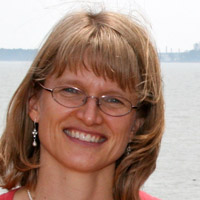VIMS professor to serve U.N. climate-modeling group
 Friedrichs and 60 other model-comparison and climate-modeling experts will meet in late January in Boulder, Colorado as part of an effort by the U.N.'s Intergovernmental Panel on Climate Change. The IPCC was established in 1989 by the U.N. and the World Meteorological Organization to provide policymakers with periodic updates on climate-change science.
Friedrichs and 60 other model-comparison and climate-modeling experts will meet in late January in Boulder, Colorado as part of an effort by the U.N.'s Intergovernmental Panel on Climate Change. The IPCC was established in 1989 by the U.N. and the World Meteorological Organization to provide policymakers with periodic updates on climate-change science.The goal of the modeling-experts group is to create benchmarks for testing climate-model accuracy, and to draw up methods for combining the many different climate models and projections that have been developed at climate centers around the world.
The group's work is an important step in the publication of the IPCC's next assessment report, the fifth in a series first issued in 1990. The 1st IPCC report played a decisive role in creation of the United Nations Framework Convention on Climate Change, the key international treaty to reduce global warming and cope with its consequences. The 2nd report of 1995 provided key input to the adoption of the Kyoto Protocol in 1997. The 3rd report came out in 2001, and the 4th in 2007. The 5th assessment report is scheduled for release in 2014.
Friedrichs was selected for the modeling group based on her experience in synthesizing projections made by different computer models. Her particular expertise is with models that simulate the interactions between ocean biology and ocean physics, and that forecast how these interactions control the movement of carbon dioxide between the ocean and the atmosphere.
"About a third of the carbon dioxide that humans release to the atmosphere ends up in the ocean," says Friedrichs. "Ocean ecosystem models help us to understand and predict how this transfer varies in time and space, and how it might change as oceans warm and habitats shift."
VIMS Dean and Director John Wells says Friedrichs' selection is an honor for the Institute, and "reflects well on the international reputation that our faculty have earned in the fields of computer modeling and data assimilation."
Friedrichs has participated in several previous model-synthesis programs. From 2001-2006, she led a project designed to combine the numerous model projections that resulted from U.S. participation in the Joint Global Flux Study. JGOFS, which ran from 1987 to 2005, was an international program designed to provide a quantitative understanding of the ocean carbon cycle.
"JGOFS really advanced our understanding of ocean biogeochemistry," says Friedrichs, "but there had been few quantitative inter-comparisons of the ecosystem models developed during the program. By comparing these models, we were able to combine their best features, and accelerate development of models that are capable of simultaneously describing the primary biogeochemical features of different ocean ecosystems."
Friedrichs is now active in projects designed to compare ecosystem models in various ocean basins around the world; and to model, analyze, and assimilate observational data concerning the workings of the carbon cycle along the U.S. Eastern Continental Shelf.
In addition to Friedrichs and other researchers from the U.S., the modeling group will include participants from Argentina, Australia, Brazil, Canada, China, Denmark, Finland, France, Germany, Japan, Korea, Mexico, Norway, Russia, South Africa, Spain, Switzerland, the United Kingdom, and Vietnam.
 Skip to main content
Skip to main content
